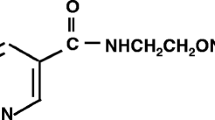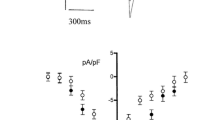Abstract.
In rabbit, ventricular myocytes loaded with indo-1/AM, angiotensin II (0.1 nM–0.1 µM) exerted a positive inotropic effect with a significant increase in the amplitude of Ca2+ transients. For a given increase in cell shortening, the increase in Ca2+ transients induced by angiotensin II was less than that induced by elevation of extracellular Ca2+ concentration ([Ca2+]o) or isoprenaline, an indication that both the increase in mobilization of intracellular Ca2+ ions and myofibrillar sensitivity to Ca2+ ions contribute to the positive inotropic effect of angiotensin II. The effects of angiotensin II on Ca2+ transients and cell shortening were inhibited by the AT1 receptor antagonist losartan. A Na+-H+ exchange inhibitor EIPA [5-(N-ethyl-N-isopropyl)amiloride] at 1 and 3 µM did not affect the Ca2+ transients and cell shortening, but it inhibited the angiotensin-II-induced responses in a concentration-dependent manner more effectively than the responses to elevation of [Ca2+]o, indicating that EIPA elicited a selective inhibitory action on the effects of angiotensin II. The observation that EIPA at 10 µM abolished the positive inotropic effect of angiotensin II without a significant depression of the inotropic response to elevation of [Ca2+]o supports the selective action of EIPA at the high concentration on the response to angiotensin II. A novel selective Na+-Ca2+ exchange (reverse mode) inhibitor KB-R7943, 2-[2-[4-(-nitrobenzyloxy)phenyl]ethyl] isothiourea methanesulphonate, at 0.3 and 1 µM inhibited also the responses to angiotensin II more effectively than the response to elevation of [Ca2+]o; however, over the same concentration range it suppressed significantly the amplitude of Ca2+ transients and cell shortening. Combination of EIPA (3 µM) and KB-R7943 (0.3 µM), each of which attenuated partially the angiotensin-II-induced responses, abolished the positive inotropic effect and the increase in Ca2+ transients induced by angiotensin II with much less depressant effect on the responses to elevation of [Ca2+]o. Thus, these ion exchange inhibitors exerted selective actions on the respective targets. The results with these selective inhibitors indicate that the activation of Na+-H+ exchanger and subsequent modulation of the activity of Na+-Ca2+ exchanger may be responsible for the increase in [Ca2+]i and the myofilament Ca2+ sensitization induced by stimulation of AT1 receptors by angiotensin II in rabbit ventricular myocytes.
Similar content being viewed by others
Author information
Authors and Affiliations
Additional information
Electronic Publication
Rights and permissions
About this article
Cite this article
Fujita, S., Endoh, M. Influence of a Na+-H+ exchange inhibitor ethylisopropylamiloride, a Na+-Ca2+ exchange inhibitor KB-R7943 and their combination on the increases in contractility and Ca2+ transient induced by angiotensin II in isolated adult rabbit ventricular myocytes. Naunyn-Schmiedeberg's Arch Pharmacol 360, 575–584 (1999). https://doi.org/10.1007/s002109900123
Received:
Accepted:
Issue Date:
DOI: https://doi.org/10.1007/s002109900123




